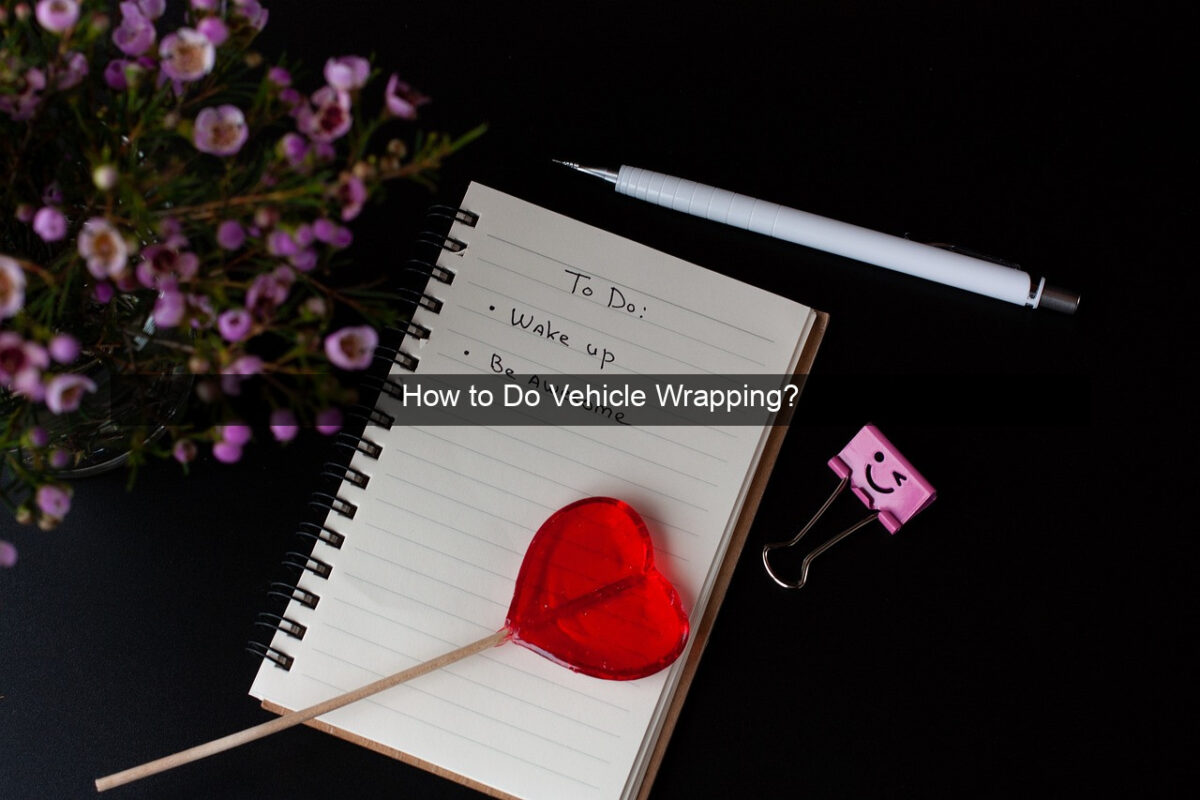How to Do Vehicle Wrapping?

- How to Do Vehicle Wrapping?
- Transform Your Ride: A Comprehensive Guide to Vehicle Wrapping
- Preparing for the Wrap
- Cleaning and Surface Preparation
- Choosing the Right Vinyl
- Tools and Equipment
- The Wrapping Process
- Applying the Vinyl
- Post-Heating and Finishing
- Maintaining Your Vehicle Wrap
- Cleaning and Care
- Conclusion

Transform Your Ride: A Comprehensive Guide to Vehicle Wrapping
Vehicle wrapping has exploded in popularity, transforming ordinary cars into eye-catching mobile advertisements or personalized works of art. This technique offers a vibrant and versatile alternative to traditional paint jobs, allowing for intricate designs, bold colors, and even unique textures. Whether you’re a business owner looking to boost brand visibility or an individual wanting to customize your vehicle, understanding the process of vehicle wrapping is essential. This comprehensive guide will equip you with the knowledge you need to navigate the world of vehicle wraps, from choosing the right materials to mastering the application techniques.
Beyond its aesthetic appeal, vehicle wrapping provides a protective layer for your car’s original paint, shielding it from minor scratches, UV rays, and road debris. This added protection preserves the resale value of your vehicle, making it a smart investment for the long term. Moreover, the versatility of vehicle wraps allows for easy removal and replacement, enabling you to change your car’s appearance as often as you like. So, whether you’re aiming for a complete transformation or a subtle enhancement, this guide will help you understand the intricacies of vehicle wrapping.

Preparing for the Wrap
Cleaning and Surface Preparation
The foundation of a successful vehicle wrap lies in meticulous preparation. Thorough cleaning is paramount, removing any dirt, grease, or contaminants that could compromise the adhesion of the vinyl. Use a dedicated automotive cleaning solution and a microfiber cloth to ensure a pristine surface. Pay special attention to areas like door handles, crevices, and the lower panels, as these are prone to accumulating dirt.
After washing, a clay bar treatment can further refine the surface, removing embedded particles that washing might miss. This step ensures a smooth and flawless finish for the vinyl application. Finally, thoroughly dry the vehicle with a clean microfiber towel to prevent any water spots or residue from interfering with the wrap.
Inspecting the vehicle for any imperfections like scratches or dents is crucial. Minor imperfections can often be addressed before wrapping, ensuring a smooth and even final result. If necessary, lightly sand and prime any affected areas before proceeding with the wrap installation.
Choosing the Right Vinyl
Selecting the appropriate vinyl is critical for both aesthetics and durability. Consider factors like the desired finish (gloss, matte, satin), color, and texture. High-quality cast vinyl is generally preferred for vehicle wraps due to its conformability and longevity. This type of vinyl can be easily molded to complex curves and contours, ensuring a seamless fit.
Different types of vinyl offer varying levels of durability and performance. Specialty vinyls, such as chrome or textured films, can create unique visual effects. Research the different options available and choose a vinyl that aligns with your aesthetic vision and budget.
Consider the lifespan of the wrap. Some vinyls are designed for short-term applications, while others can last for several years. Choosing the right vinyl will ensure that your wrap looks its best for the desired duration.
Tools and Equipment
Having the right tools is essential for a successful vehicle wrap installation. A heat gun is crucial for conforming the vinyl to the vehicle’s curves and activating the adhesive. Squeegees, of varying sizes and hardness, are used to smooth out the vinyl and remove air bubbles. A sharp knife or blade is necessary for precise trimming and cutting.
Other essential tools include masking tape for creating clean lines and edges, magnets to hold the vinyl in place during application, and a measuring tape for accurate measurements. Investing in high-quality tools will make the installation process smoother and contribute to a more professional finish.
Having a clean and organized workspace is also important. A dust-free environment will minimize the risk of contaminants getting trapped under the vinyl. Ensure you have ample lighting to clearly see the surface and identify any imperfections during the installation process.
The Wrapping Process
Applying the Vinyl
Begin by positioning the vinyl panel on the vehicle, ensuring proper alignment. Use magnets to hold the vinyl in place and prevent it from shifting. Start by applying the vinyl to a small section, gradually working your way outwards. Use a squeegee to smooth out the vinyl and remove any air bubbles.
Apply consistent pressure with the squeegee, working from the center outwards to push out any trapped air. Overlapping panels slightly is necessary to ensure complete coverage. Use a heat gun to soften the vinyl, allowing it to conform to curves and recesses.
Patience and precision are key during this stage. Take your time and work methodically to ensure a smooth and wrinkle-free application. If air bubbles persist, use a pin to create a small puncture and gently push out the air with a squeegee.
Post-Heating and Finishing
Once the vinyl is applied, post-heating is crucial for activating the adhesive and ensuring a strong bond. Use a heat gun to evenly heat the entire surface of the wrap, paying particular attention to edges and contours. This step helps the vinyl conform to the vehicle’s shape and prevents lifting or peeling.
After post-heating, carefully inspect the wrap for any imperfections. Address any remaining air bubbles or wrinkles. Trim any excess vinyl using a sharp knife or blade, ensuring clean and precise edges.
Finally, allow the wrap to cool and cure for several hours before exposing it to the elements. This will ensure that the adhesive has fully bonded and the wrap is properly secured to the vehicle.
Maintaining Your Vehicle Wrap
Cleaning and Care
Proper maintenance will prolong the life of your vehicle wrap. Hand washing is recommended, using a mild detergent and a soft sponge or microfiber cloth. Avoid abrasive cleaners or high-pressure washes, as these can damage the vinyl.
Regularly waxing the wrap can provide additional protection against UV rays and environmental contaminants. This will help maintain the vibrancy of the color and prevent fading or discoloration.
Avoid parking in direct sunlight for extended periods, as this can accelerate the aging process of the vinyl. If possible, park in shaded areas or use a car cover to protect the wrap from excessive sun exposure.
Conclusion
Vehicle wrapping offers a dynamic and versatile way to transform your vehicle’s appearance. From promoting your business to expressing your personal style, the possibilities are endless. By understanding the process and investing the necessary time and effort, you can achieve a stunning and long-lasting result. Remember, proper preparation and meticulous application are crucial for a successful wrap. With patience and attention to detail, you can transform your ride into a head-turning masterpiece.
How long does a vehicle wrap typically last?
A professionally installed vehicle wrap can last anywhere from 3 to 7 years, depending on the quality of the vinyl and the environmental conditions.
Can I wrap my car myself?
While it’s possible to wrap a car yourself, it’s a challenging process that requires skill and precision. Professional installation is recommended for the best results.
How much does it cost to wrap a vehicle?
The cost of a vehicle wrap varies depending on the size of the vehicle, the type of vinyl used, and the complexity of the design. It’s best to get quotes from several reputable installers.
Can a vehicle wrap be removed?
Yes, a vehicle wrap can be removed without damaging the original paint, provided it’s done correctly. Professional removal is recommended.
What are the benefits of vehicle wrapping over painting?
Vehicle wrapping offers several advantages over painting, including greater design flexibility, paint protection, and easier removal and replacement.


